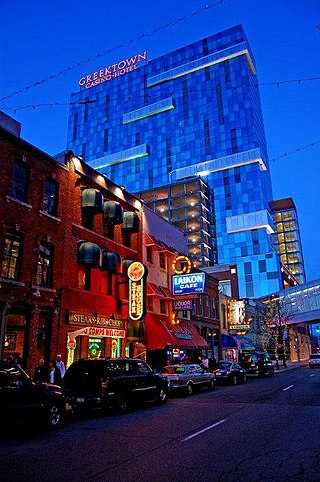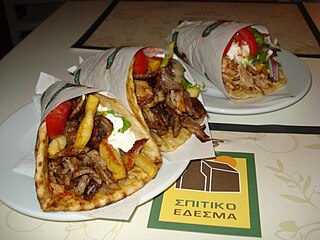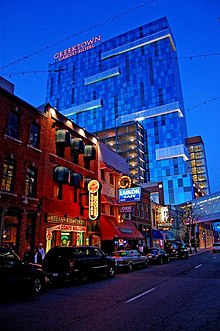
Metro Detroit is a major metropolitan area in the U.S. state of Michigan, consisting of the city of Detroit and over 200 municipalities in the surrounding area with its largest employer being Oakland County. There are varied definitions of the area, including the official statistical areas designated by the Office of Management and Budget, a federal agency of the United States.

A Coney Island is a type of restaurant that is popular in the northern United States, particularly in Michigan as well as the name for the Coney Island hot dog after which the restaurant style is named.

Greektown is a commercial and entertainment district in Detroit, Michigan, located just northeast of the heart of downtown, along Monroe Avenue between Brush and St. Antoine streets. It has a station by that name on the city's elevated downtown transit system known as the Detroit People Mover. Greektown is situated between the Renaissance Center, Comerica Park, and Ford Field.

A Coney Island hot dog, Coney dog, or Coney is a hot dog in a bun topped with a savory meat sauce and sometimes other toppings. It is often offered as part of a menu of classic American "diner" dishes and often at Coney Island restaurants. It is largely a phenomenon related to immigration from Greece and the region of Macedonia to the United States in the early 20th century.

Macedonian Americans are Americans of ethnic Macedonian heritage.

St. Mary Roman Catholic Church, formally the Church of the Immaculate Conception of the Blessed Virgin Mary, is in the third oldest Roman Catholic parish in Detroit, Michigan. Designed by German-born Peter Dederichs and built for the formerly ethnic German parish of the 19th century, it is located at 646 Monroe Street in what is now considered the heart of the Greektown Historic District in downtown Detroit. It is often called "Old St. Mary's Church" to avoid confusion with other St. Mary's parishes: in the Redford neighborhood of Detroit, or in nearby Royal Oak, Monroe, or Wayne.

Greek-American cuisine is the cuisine of Greek Americans and their descendants, who have modified Greek cuisine under the influence of American culture and immigration patterns of Greeks to the United States. As immigrants from various Greek areas settled in different regions of the United States and became "Greek Americans," they carried with them different traditions of foods and recipes that were particularly identified with their regional origins in Greece and yet infused with the characteristics of their new home locale in America. Many of these foods and recipes developed into new favorites for town peoples and then later for Americans nationwide. Greek-American cuisine is especially prominent in areas of concentrated Greek communities, such as Astoria, Queens and Tarpon Springs, Florida.

National Coney Island is a Coney Island-style restaurant based in Michigan that specializes in Greek-American cuisine. It is a corporation that has more than 20 National Coney Island locations in the Metro Detroit area.
As of the census of 2010, there were 5,196,250 people, 1,682,111 households, and 1,110,454 families residing within the Detroit–Warren–Ann Arbor Combined Statistical Area. Within the Detroit–Warren–Dearborn Metropolitan Statistical Area, there were 4,296,250 people residing. The census reported 70.1% White, 22.8% African-American, 0.3% Native American, 3.3% Asian, 0.02% Pacific Islander, 1.2% from other races, and 2.2% from two or more races. Hispanic or Latino of any race were 6.2% of the population. Arab Americans were at least 4.7% of the region's population.

In 2004, Metro Detroit had one of the largest settlements of Middle Eastern people, including Arabs and Chaldo-Assyrians in the United States. As of 2007 about 300,000 people in Southeast Michigan traced their descent from the Middle East. Dearborn's sizeable Arab community consists largely of Lebanese people who immigrated for jobs in the auto industry in the 1920s, and of more recent Yemenis and Iraqis. In 2010 the four Metro Detroit counties had at least 200,000 people of Middle Eastern origin. Bobby Ghosh of TIME said that some estimates gave much larger numbers. From 1990 to 2000 the percentage of people speaking Arabic in the home increased by 106% in Wayne County, 99.5% in Macomb County, and 41% in Oakland County.
In 2002, there were 6,413 people of Japanese origin, including Japanese citizens and Japanese Americans, in the Wayne-Oakland-Macomb tri-county area in Metro Detroit, making them the fifth-largest Asian ethnic group there. In that year, within an area stretching from Sterling Heights to Canton Township in the shape of a crescent, most of the ethnic Japanese lived in the center. In 2002, the largest populations of ethnic Japanese people were located in Novi and West Bloomfield Township. In April 2013, the largest Japanese national population in the State of Michigan was in Novi, with 2,666 Japanese residents. West Bloomfield had the third-largest Japanese population and Farmington Hills had the fourth largest Japanese population.
As of 2002, ethnic Chinese and Chinese American people comprise the second-largest Asian-origin ethnic group in the Wayne–Macomb–Oakland tri-county area in Metro Detroit. As of that year there were 16,829 ethnic Chinese, concentrated mainly in Troy, Rochester Hills, and Canton Township. As of 2012, Madison Heights also hosts a significant Chinese community.
The Hungarian people and Hungarian Americans immigrated to Metro Detroit in the 20th century. Historically they populated Delray in Detroit but moved to the Downriver area in the 1960s. There were four historic waves of Hungarian immigration to Detroit.
In 2023, Polish Americans are most heavily concentrated in the Upper Midwest and Northeast regions of the United States. As the second most Polish populated state, Michigan follows closely behind Wisconsin with 784,200 people identifying as Polish, or 7.82% of the state's population, identifying as Polish. Many of these Polish Americans live in the Metro Detroit area of Michigan.
The National Italian American Foundation estimated that in 1990, Metro Detroit had 280,000 ethnic Italians.
A 2013 report by the Global Detroit and Data Driven Detroit stated that of the immigrant ethnic groups to Metro Detroit, the largest segment is the Indian population. As of 2012, the Indian populations of Farmington Hills and Troy are among the twenty largest Indian communities in the United States. As of the 2000 U.S. Census there were 39,527 people with origins from post-partition India in Metro Detroit, making them the largest Asian ethnic group in the Wayne County-Macomb County-Oakland County tri-county area. People of those origins are found throughout Metro Detroit, with the majority being in Oakland County.

In 2004 58.5% of the people of Hispanic origin in the Wayne County-Macomb County-Oakland County tri-county area were Mexicans.

Metro Detroit has the following ethnic groups:
The organization Global Detroit stated that the largest group of ethnic Albanians not in Europe is in Metro Detroit. As of 2014, 4,800 ethnic Albanians live in Macomb County, making up the fourth-largest ethnic group in that county, and the highest concentration of Albanians in Metro Detroit.












